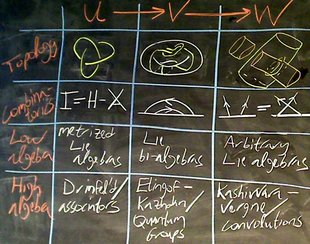|
|
| (3 intermediate revisions by 3 users not shown) |
| Line 1: |
Line 1: |
|
|
{{AKT-09/Navigation}} |
|
The tricolourability criterion for knot diagrams may be equivalently expressed as: is it possible to associate to each strand a member of Z/3Z such that, for each crossing, the sum of the three numbers associated to the three strands involved is 0 mod 3 (that is, the three numbers are either all distinct or all the same) while excluding the case of associating the same member to every strand. |
|
The tricolourability criterion for knot diagrams may be equivalently expressed as: is it possible to associate to each arc (not 'strand' since you are allowed to change color after an undercrossing; this allowance makes sense because otherwise we would end up with a single color for the whole knot; see example of how to colour a knot diagram and a picture proof that tricolourability is a isotopy invariant at http://en.wikipedia.org/wiki/Tricolorability) a member of Z/3Z such that, for each crossing, the sum of the three numbers associated to the three arcs involved is 0 mod 3 (that is, the three numbers are either all distinct or all the same) while excluding the case of associating the same number to every arc? |
|
|
|
|
|
This fact can be exploited to give an algorithm for determining tricolourability of a knot diagram whose complexity is polynomial in the number of crossings. (A naive test which tried all possible colourings would require 3^(number of strands) checks.) |
|
This fact can be exploited to give an algorithm for determining tricolourability of a knot diagram whose complexity is polynomial in the number of crossings. (A naive test which tried all possible colourings would require 3^(number of arcs) checks.) |
|
|
|
|
|
Define the variables S1...Sn which are associated with the strands of a knot diagram D. Each crossing yields an equation of the form Sa + Sb + Sc = 0. We add the restriction S1 = 0 (without loss of generality) and with the added benefit that the trivial colouring is easily recognized as the trivial solution to the equation Mx = 0 where x = (S1, ..., Sn) and M is the matrix over Z/3Z encoding the aforementioned relations. The nullity of M is non-zero if and only if there is a valid tricolouring of D. |
|
Define the variables <math>S_1 , ... , S_n</math> which are associated with the arcs of a knot diagram D. Each crossing yields an equation of the form <math>S_a + S_b + S_c = 0</math>. We can also (without loss of generality) assume <math>S_1 = 0</math>. Let M be the matrix over Z/3Z encoding the aforementioned relations. The nullity of M is non-zero if and only if there is a valid tricolouring of D. |
Latest revision as of 18:13, 18 September 2009
| #
|
Week of...
|
Videos, Notes, and Links
|
| 1
|
Sep 7
|
About This Class
 090910-1: 3-colourings, Reidemeister's theorem, invariance, the Kauffman bracket. 090910-1: 3-colourings, Reidemeister's theorem, invariance, the Kauffman bracket.
 090910-2: R23 invariance of the bracket, R1, the writhe, the Jones polynomial, programming the Jones polynomial. 090910-2: R23 invariance of the bracket, R1, the writhe, the Jones polynomial, programming the Jones polynomial.
Tricolourability
|
| 2
|
Sep 14
|
 090915: More on Jones, some pathologies and more on Reidemeister, our overall agenda. 090915: More on Jones, some pathologies and more on Reidemeister, our overall agenda.
 090917-1: The definition of finite type, weight systems, Jones is a finite type series. 090917-1: The definition of finite type, weight systems, Jones is a finite type series.
 090917-2: The skein relation for Jones; HOMFLY-PT and Conway; the weight system of Jones. 090917-2: The skein relation for Jones; HOMFLY-PT and Conway; the weight system of Jones.
|
| 3
|
Sep 21
|
 090922: FI, 4T, HOMFLY and FI and 4T, statement of the Fundamental Theorem, framed knots. 090922: FI, 4T, HOMFLY and FI and 4T, statement of the Fundamental Theorem, framed knots.
 090924-1: Some dimensions of 090924-1: Some dimensions of  , ,  is a commutative algebra, is a commutative algebra,  . .
Class Photo
 090924-2: 090924-2:  is a co-commutative algebra, the relation with products of invariants, is a co-commutative algebra, the relation with products of invariants,  is a bi-algebra. is a bi-algebra.
|
| 4
|
Sep 28
|
Homework Assignment 1
Homework Assignment 1 Solutions
 090929: The Milnor-Moore theorem, primitives, the map 090929: The Milnor-Moore theorem, primitives, the map  . .
 091001-1: Jacobi diagrams, AS, IHX, STU, and the equivalence of all that with 4T. 091001-1: Jacobi diagrams, AS, IHX, STU, and the equivalence of all that with 4T.
 091001-2: The very basics on Lie algebras. 091001-2: The very basics on Lie algebras.
|
| 5
|
Oct 5
|
 091006: Lie algebraic weight systems, 091006: Lie algebraic weight systems,  . .
 091008-1: More on 091008-1: More on  , Lie algebras and the four colour theorem. , Lie algebras and the four colour theorem.
 091008-2: The "abstract tenssor" approach to weight systems, 091008-2: The "abstract tenssor" approach to weight systems,  and PBW, the map and PBW, the map  . .
|
| 6
|
Oct 12
|
 091013: Algebraic properties of 091013: Algebraic properties of  vs. algebraic properties of vs. algebraic properties of  . .
Thursday's class canceled.
|
| 7
|
Oct 19
|
 091020: Universal finite type invariants, filtered and graded spaces, expansions. 091020: Universal finite type invariants, filtered and graded spaces, expansions.
Homework Assignment 2
The Stonehenge Story
 091022-1: The Stonehenge Story to IHX and STU. 091022-1: The Stonehenge Story to IHX and STU.
 091022-2: The Stonhenge Story: anomalies, framings, relation with physics. 091022-2: The Stonhenge Story: anomalies, framings, relation with physics.
|
| 8
|
Oct 26
|
 091027: Knotted trivalent graphs and their chord diagrams. 091027: Knotted trivalent graphs and their chord diagrams.
 091029-1: Zsuzsi Dancso on the Kontsevich Integral (1). 091029-1: Zsuzsi Dancso on the Kontsevich Integral (1).
 091029-2: Zsuzsi Dancso on the Kontsevich Integral (2). 091029-2: Zsuzsi Dancso on the Kontsevich Integral (2).
|
| 9
|
Nov 2
|
 091103: The details of 091103: The details of  . .
 091105-1: Three basic problems: genus, unknotting numbers, ribbon knots. 091105-1: Three basic problems: genus, unknotting numbers, ribbon knots.
 091105-2: The three basic problems and algebraic knot theory. 091105-2: The three basic problems and algebraic knot theory.
|
| 10
|
Nov 9
|
 091110: Tangles and planar algebras, shielding and the generators of KTG. 091110: Tangles and planar algebras, shielding and the generators of KTG.
Homework Assignment 3
No Thursday class.
|
| 11
|
Nov 16
|
Local Khovanov Homology
 091119-1: Local Khovanov homology, I. 091119-1: Local Khovanov homology, I.
 091119-2: Local Khovanov homology, II. 091119-2: Local Khovanov homology, II.
|
| 12
|
Nov 23
|
 091124: Emulation of one structure inside another, deriving the pentagon. 091124: Emulation of one structure inside another, deriving the pentagon.
 091126-1: Peter Lee on braided monoidal categories, I. 091126-1: Peter Lee on braided monoidal categories, I.
 091126-2: Peter Lee on braided monoidal categories, II. 091126-2: Peter Lee on braided monoidal categories, II.
|
| 13
|
Nov 30
|
 091201: The relations in KTG. 091201: The relations in KTG.
 091203-1: The Existence of the Exponential Function. 091203-1: The Existence of the Exponential Function.
 091203-2: The Final Exam, Dror's failures. 091203-2: The Final Exam, Dror's failures.
|
| F
|
Dec 7
|
The Final Exam on Thu Dec 10, 9-11, Bahen 6183.
|
| Register of Good Deeds / To Do List
|

Add your name / see who's in!
|

|
|
The tricolourability criterion for knot diagrams may be equivalently expressed as: is it possible to associate to each arc (not 'strand' since you are allowed to change color after an undercrossing; this allowance makes sense because otherwise we would end up with a single color for the whole knot; see example of how to colour a knot diagram and a picture proof that tricolourability is a isotopy invariant at http://en.wikipedia.org/wiki/Tricolorability) a member of Z/3Z such that, for each crossing, the sum of the three numbers associated to the three arcs involved is 0 mod 3 (that is, the three numbers are either all distinct or all the same) while excluding the case of associating the same number to every arc?
This fact can be exploited to give an algorithm for determining tricolourability of a knot diagram whose complexity is polynomial in the number of crossings. (A naive test which tried all possible colourings would require 3^(number of arcs) checks.)
Define the variables  which are associated with the arcs of a knot diagram D. Each crossing yields an equation of the form
which are associated with the arcs of a knot diagram D. Each crossing yields an equation of the form  . We can also (without loss of generality) assume
. We can also (without loss of generality) assume  . Let M be the matrix over Z/3Z encoding the aforementioned relations. The nullity of M is non-zero if and only if there is a valid tricolouring of D.
. Let M be the matrix over Z/3Z encoding the aforementioned relations. The nullity of M is non-zero if and only if there is a valid tricolouring of D.












